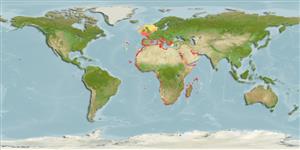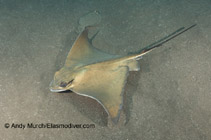Myliobatis aquila (Linnaeus, 1758)
Common eagle ray
Ajouter votre observation dans Fish Watcher
| Native range | All suitable habitat | Point map | Year 2050 |

|
| This map was computer-generated and has not yet been reviewed. |
| Myliobatis aquila AquaMaps Data sources: GBIF OBIS |
Slovenia country information
Common names:
Morski golob
Occurrence: native
Salinity: marine
Abundance: common (usually seen) | Ref:
Importance: | Ref:
Aquaculture: | Ref:
Regulations: | Ref:
Uses: no uses
Comments:
National Checklist:
Country Information: https://www.cia.gov/library/publications/resources/the-world-factbook/geos/si.html
National Fisheries Authority:
Occurrences: Occurrences Point map
Main Ref: McEachran, J.D. and C. Capapé, 1984
National Database:
Occurrence: native
Salinity: marine
Abundance: common (usually seen) | Ref:
Importance: | Ref:
Aquaculture: | Ref:
Regulations: | Ref:
Uses: no uses
Comments:
National Checklist:
Country Information: https://www.cia.gov/library/publications/resources/the-world-factbook/geos/si.html
National Fisheries Authority:
Occurrences: Occurrences Point map
Main Ref: McEachran, J.D. and C. Capapé, 1984
National Database:
Common names from other countries
Classification / Names Noms communs | Synonymes | Catalog of Fishes(Genre, Espèce) | ITIS | CoL | WoRMS | Cloffa
Élasmobranches (requins et raies) (sharks and rays) > Myliobatiformes (Stingrays) > Myliobatidae (Eagle and manta rays)
Etymology: Myliobatis: Greek, mylo = mill + Greek, + Greek, batis,-idos = a ray (Raja sp.) (Ref. 45335).
More on author: Linnaeus.
Etymology: Myliobatis: Greek, mylo = mill + Greek, + Greek, batis,-idos = a ray (Raja sp.) (Ref. 45335).
More on author: Linnaeus.
Environment: milieu / climate zone / depth range / distribution range Écologie
marin; saumâtre benthopélagique; profondeur 1 - 300 m (Ref. 4440). Subtropical; 60°N - 36°S, 32°W - 58°E
Distribution Pays | Zones FAO | Écosystèmes | Occurrences | Point map | Introductions | Faunafri
Eastern Atlantic: Madeira, Morocco and the Canary Islands north to the western coasts of Ireland and British Isles and the southwestern North Sea, south to Natal, South Africa. Also throughout the Mediterranean.
Length at first maturity / Taille / Poids / Âge
Maturity: Lm ?, range 60 - ? cm
Max length : 183 cm WD mâle / non sexé; (Ref. 4440); poids max. publié: 14.5 kg (Ref. 40637)
Max length : 183 cm WD mâle / non sexé; (Ref. 4440); poids max. publié: 14.5 kg (Ref. 40637)
Description synthétique Clés d'identification | Morphologie | Morphométrie
A plain eagleray with a short, rounded snout; disc with broadly angular corners, and upper or lower jaw usually with 7 rows of plate-like teeth (Ref. 5578). Brown or blackish dorsally, white ventrally (Ref. 5578). No caudal fin (Ref. 5578).
Found in shallow lagoons (Ref. 3965), bays and estuaries; also offshore down to at least 95 m (Ref. 5578). Often found in groups (Ref. 5578). Feeds on benthic crustaceans, mollusks and fish. Ovoviviparous (Ref. 50449). Gestation period of 6-8 months, the females give birth to 3-7 young (Ref. 35388). Caught by shore and ski-boat anglers, usually released after capture (Ref. 5578). Flesh is highly esteemed (Ref. 3965).
Life cycle and mating behavior Maturité | Reproduction | Frai | Œufs | Fécondité | Larves
Exhibit ovoviparity (aplacental viviparity), with embryos feeding initially on yolk, then receiving additional nourishment from the mother by indirect absorption of uterine fluid enriched with mucus, fat or protein through specialised structures (Ref. 50449).
Référence principale
Upload your references | Références | Coordinateur : McEachran, John | Collaborateurs
McEachran, J.D. and B. Séret, 1990. Myliobatididae. p. 67-70. In J.C. Quero, J.C. Hureau, C. Karrer, A. Post and L. Saldanha (eds.) Check-list of the fishes of the eastern tropical Atlantic (CLOFETA). JNICT, Lisbon; SEI, Paris; and UNESCO, Paris. Vol. 1. (Ref. 4440)
Statut dans la liste rouge de l'IUCN (Ref. 130435: Version 2024-2)
Niveau de menace critique (CR) (A2bd); Date assessed: 04 August 2020
Menace pour l'homme
Harmless
Utilisations par l'homme
Pêcheries: intérêt commercial mineur; pêche sportive: oui
FAO(pêcheries: production; publication : search) | FishSource | Sea Around Us
Plus d'informations
Trophic ecology
Éléments du régime alimentaire
Composition du régime alimentaire
Consommation alimentaire
Food rations
Prédateurs
Éléments du régime alimentaire
Composition du régime alimentaire
Consommation alimentaire
Food rations
Prédateurs
Population dynamics
Paramètres de croissance
Max. ages / sizes
Length-weight rel.
Length-length rel.
Fréquences de longueurs
Mass conversion
Recrutement
Abondance
Paramètres de croissance
Max. ages / sizes
Length-weight rel.
Length-length rel.
Fréquences de longueurs
Mass conversion
Recrutement
Abondance
Life cycle
Reproduction
Maturité
Fécondité
Frai
Spawning aggregations
Œufs
Développement de l'œuf
Larves
Dynamique des populations larvaires
Reproduction
Maturité
Fécondité
Frai
Spawning aggregations
Œufs
Développement de l'œuf
Larves
Dynamique des populations larvaires
Anatomy
Surface branchiale
Brain
Otolith
Surface branchiale
Brain
Otolith
Physiology
Body composition
Nutrients
Consommation d'oxygène
Type de nage
Vitesse de nage
Visual pigments
Fish sound
Diseases & Parasites
Toxicity (LC50s)
Body composition
Nutrients
Consommation d'oxygène
Type de nage
Vitesse de nage
Visual pigments
Fish sound
Diseases & Parasites
Toxicity (LC50s)
Human related
Aquaculture systems
Profils d'aquaculture
Souches
Ciguatera cases
Stamps, coins, misc.
Aquaculture systems
Profils d'aquaculture
Souches
Ciguatera cases
Stamps, coins, misc.
Outils
Bio-Quiz | E-book | Guide de terrain | Générateur de fréquences de longueur | Outil de dynamique de population | Carte par point | Classification Tree
| Catch-MSY |
Articles particuliers
Télécharger en XML
Sources Internet
Aquatic Commons | BHL | Cloffa | Websites from users | FishWatcher | CISTI | Catalog of Fishes(Genre, Espèce) | DiscoverLife | DORIS | ECOTOX | Faunafri | Fishtrace | GenBank(génôme, nucléotide) | GloBI | GOBASE | | Google Books | Google Scholar | Google | IGFA World Record | MitoFish | Bases de données nationales | Otolith Atlas of Taiwan Fishes | Aquariums publics | PubMed | Reef Life Survey | Scirus | SeaLifeBase | Arbre de Vie | Wikipedia(aller à, chercher) | World Records Freshwater Fishing | Zoological Record
Estimates based on models
Preferred temperature (Ref. 115969): 11.7 - 19.8, mean 15.2 (based on 318 cells).
Phylogenetic diversity index (Ref. 82804): PD50 = 0.5002 [Uniqueness, from 0.5 = low to 2.0 = high].
Bayesian length-weight: a=0.00389 (0.00119 - 0.01269), b=3.08 (2.83 - 3.33), in cm Total Length, based on LWR estimates for this (Sub)family-body shape (Ref. 93245).
Niveau trophique (Ref. 69278): 3.6 ±0.54 se; based on food items.
Résilience (Ref. 120179): Très faible, temps minimum de doublement de population supérieur à 14 ans (Fec=3).
Fishing Vulnerability (Ref. 59153): Very high vulnerability (83 of 100).
Climate Vulnerability (Ref. 125649): Moderate to high vulnerability (47 of 100).




